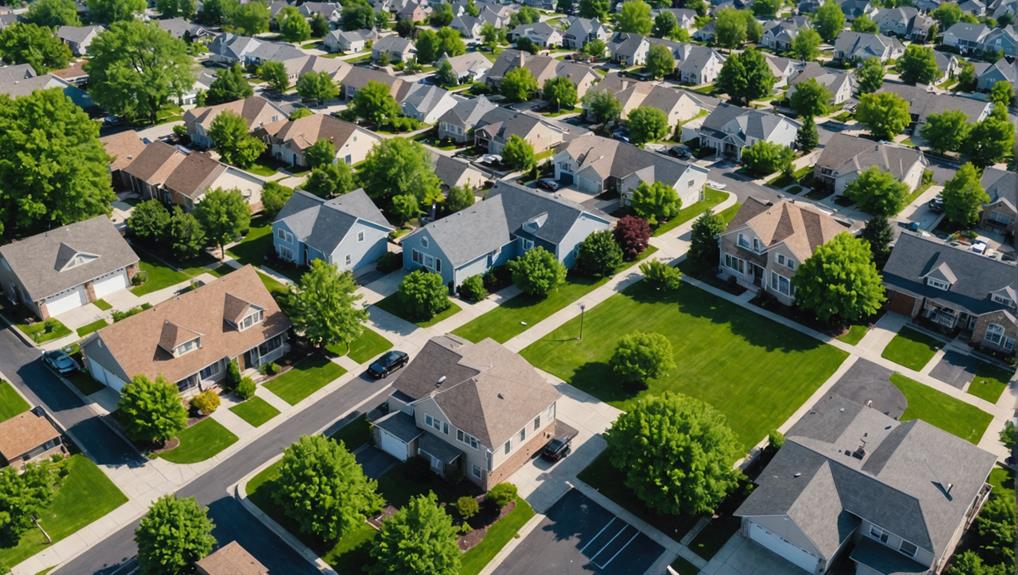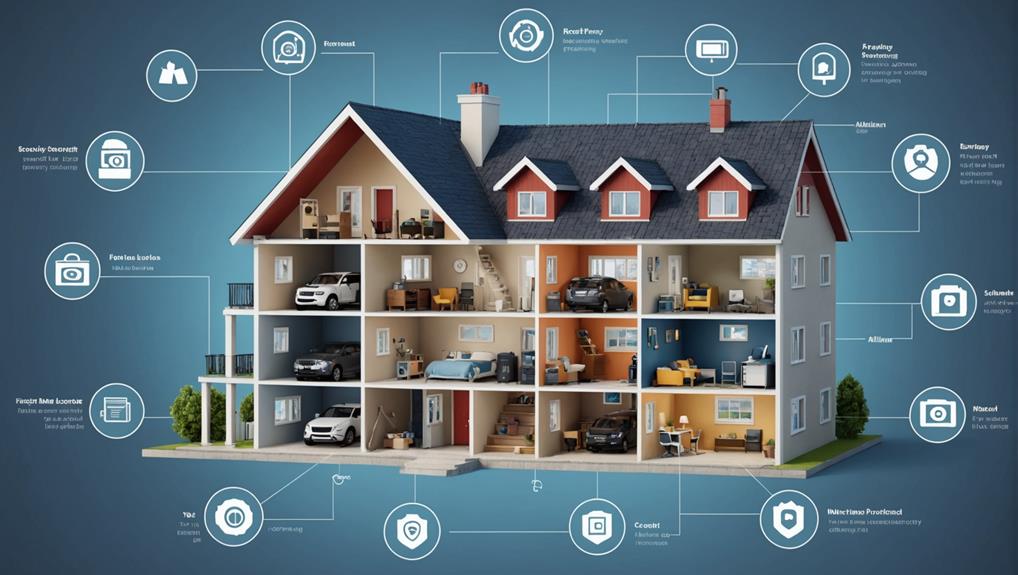Evaluating your home's security needs starts with conducting yearly evaluations to pinpoint vulnerabilities and analyze risks. Draw up a detailed inventory of your assets and involve all household members to devise a personalized security plan tailored to your specific requirements. Secure main entry points like doors and windows with strong locks and consider adding secondary barriers for extra protection. Enhancing your perimeter with proper lighting, trimming overgrown shrubs, and ensuring all entry points are secure will bolster your defenses. Remember, regularly updating security measures and staying informed about new technologies are essential steps in safeguarding your home.
Key Takeaways
- Conduct annual home security evaluations to adapt to evolving threats.
- Identify vulnerable entry points like doors and windows for assessment.
- Engage all household members in security planning for shared responsibility.
- Develop a personalized security plan tailored to specific home needs.
- Document physical and digital assets for comprehensive security evaluation.
Understanding Security Assessment Basics

When it comes to evaluating your home security needs, understanding the basics of security evaluation is fundamental. Conducting a home protection evaluation involves systematically identifying vulnerabilities and analyzing security risks to enhance the safety of your household and possessions.
This evaluation serves as the cornerstone for developing a personalized security plan that addresses your specific needs effectively. It's recommended to perform basic evaluations annually to adapt to evolving threats, with more frequent checks for properties at higher risk. If you notice that your current system is outdated or missing newer features, it may be time to upgrade your home security system to guarantee extensive protection.
The process of evaluating home security includes documenting physical and digital assets, analyzing potential threats, and devising strategies to mitigate risks effectively.
Engaging all members of your household in the security evaluation not only encourages shared responsibility but also raises awareness of specific vulnerabilities within your home. By understanding the basics of security evaluation, you can proactively safeguard your residence and loved ones against potential security threats.
Identifying Vulnerable Entry Points

You need to be aware of the vulnerable entry points in your home, such as ground-level doors and windows that are often targeted by intruders.
Additionally, don't overlook secondary entry points like garage doors and basement windows, which can also be exploited.
Identifying these weak spots is essential for enhancing your home's security and deterring potential break-ins.
Entry Point Assessment
To enhance the security of your home effectively, conducting an Entry Point Evaluation is essential.
Start by reviewing ground-level entry points like front and back doors, as well as first-floor windows, which are common targets for intruders. Since burglaries often happen during daylight hours, ensuring all entry points are secure even when you're away is vital.
Upgrade to high-security locks and reinforce door structures, as weak locks and compromised frames can provide easy access for burglars. Consider installing secondary locks or barriers on sliding glass doors, a common entry point for intruders.
Additionally, landscaping can play a role in deterring access to vulnerable areas; planting thorny bushes near windows can create natural barriers against potential intruders.
Vulnerability Identification
Amidst the quest to fortify your home's security measures, pinpointing vulnerable entry points holds paramount importance. Ground-level entry points like front doors and first-floor windows are prime targets for intruders, making them vital areas to evaluate. Approximately 60% of burglaries happen through open doors and windows, underscoring the need to secure them with robust locks and a suitable security system.
Overgrown shrubs and poorly lit areas near entry points offer cover for potential intruders, emphasizing the importance of ensuring clear visibility and well-maintained landscaping.
Choosing the right security system and evaluating security risks can greatly enhance your home's protection. Installing deadbolt locks, which are notably more secure than spring bolts, can deter unauthorized access and reinforce door security.
Regularly inspecting and fortifying door frames and window locks is essential to identify and address weaknesses that burglars could exploit. By addressing these vulnerabilities, you can strengthen your home's defenses and minimize the risk of break-ins.
Security Enhancement Suggestions
When evaluating home security needs, it's essential to focus on enhancing the protection of vulnerable entry points.
Start by thoroughly inspecting all access areas like front and back doors, first-floor windows, and garage entryways, as these are common targets for intruders. Reinforce doors with deadbolt locks, known to be 15 times more secure than spring bolts, and consider smart locks for added convenience and security.
Ensure window security with secondary locks, security film to prevent shattering, and pin locks for sliding windows and doors.
Use landscaping strategically by trimming bushes and planting thorny shrubs under windows to deter intruders. Keep outdoor lighting updated, especially with motion-activated lights near entry points, as well-lit properties can decrease crime by up to 30%, making it harder for potential burglars to approach undetected.
Taking these security enhancement suggestions seriously will help fortify your home against potential threats and provide peace of mind for you and your loved ones.
Enhancing Perimeter Security Measures

To enhance your home's perimeter security, guarantee that overgrown shrubs and trees near windows are trimmed to improve visibility and eliminate potential hiding spots.
Regularly maintaining your landscaping can also deter intruders by reducing dark, obscured areas around your property.
Consider installing solid-core doors with deadbolt locks to fortify your entry points against forced entry attempts greatly.
Additionally, utilizing motion-activated lighting and securing all gates and fences with sturdy locks can further bolster your home's security measures.
Lighting for Visibility
Improving visibility around your property is essential for enhancing perimeter security measures. By installing motion-activated lights near entry points and pathways, you can deter potential intruders and reduce criminal activity by up to 30%.
Well-lit outdoor spaces eliminate hiding spots for burglars, making your property less appealing during nighttime or low-light conditions. Consider using solar-powered lights to enhance security while keeping energy costs down, ensuring consistent illumination without the need for electrical wiring.
Setting timers for outdoor lights can create the illusion of occupancy when you're away, further deterring burglars during daylight hours.
Remember, adequate exterior lighting not only boosts visibility but also signals active monitoring, letting potential intruders know that your property is under watch.
Access Control Measures
Enhance the security of your property by implementing effective access control measures to fortify your perimeter.
When it comes to access control, consider the following:
- Install deadbolt locks on all exterior doors to deter unauthorized entry and greatly boost security.
- Utilize high-security locks with key control systems to limit access and prevent unauthorized key duplication, adding an extra layer of protection.
- Implement keyless entry systems or smart locks for remote access control and monitoring, allowing you to manage home entry even when you're not around.
Implementing Digital Security Strategies

Amidst the digital landscape of today, securing your home against potential cyber threats is vital. Start by implementing strong passwords for all devices and accounts, incorporating a mix of letters, numbers, and special characters to enhance protection.
Remember to regularly update software and operating systems to patch vulnerabilities that cybercriminals may exploit. Utilize firewalls and antivirus programs to safeguard against malware and intrusions, reducing the risk of falling victim to cyber attacks.
In addition, integrating AI and machine learning into smart home security systems can greatly enhance threat detection and response.
Educate all household members about online privacy practices and the dangers of phishing scams to effectively mitigate cyber threats.
Moreover, consider using home automation systems for enhanced security, enabling remote monitoring and control over devices to deter potential intruders.
These measures are essential, as statistics show that 60% of small businesses close within six months of a cyber attack.
Stay vigilant and proactive in implementing these digital security strategies to safeguard your home and loved ones.
Assessing Neighborhood Crime Trends

When evaluating neighborhood crime trends, it's essential to gather relevant data and insights to better understand the safety dynamics in your area. A critical step in this process is understanding how an all-encompassing security system can contribute to crime prevention.
To effectively assess the crime trends in your neighborhood, consider the following:
- Investigate Local Crime Statistics: Look into community reports or online crime maps to pinpoint recent trends and hotspots for property crime.
- Engage with Local Police Departments: Gain valuable insights into prevalent crime patterns and learn about initiatives aimed at reducing criminal activity in your area.
- Join or Form a Neighborhood Watch Program: Collaborate with your neighbors to enhance vigilance and decrease burglaries by over 30%.
Involving Family in Security Planning

Encouraging family involvement in security planning is essential for creating a thorough and effective safety strategy for your home. By engaging your loved ones in discussions and activities related to home security, you not only empower them to protect themselves but also strengthen the overall security of your household.
Consider the following ways to involve your family in security planning:
| Activity | Purpose | Benefit |
|---|---|---|
| Conducting security drills | Guarantees readiness in emergency situations | Familiarizes everyone with response protocols |
| Discussing security measures | Identifies unique needs and concerns | Tailors security strategies to specific vulnerabilities |
| Participating in security assessments | Enhances vigilance and risk awareness | Identifies potential weaknesses and risks |
| Educating on proactive habits | Reinforces the importance of security practices | Strengthens security habits and awareness |
Evaluating Personal Property Protection

To guarantee the security of your personal property, it's vital to evaluate and implement effective protection measures. Keeping valuables such as cash, jewelry, and electronics out of sight greatly reduces the likelihood of being targeted by burglars.
Residential burglaries account for 60% of all break-ins in the U.S., making this step essential. Consider storing valuables in a safe or safety deposit box to make them inaccessible to intruders.
Additionally, maintaining a detailed inventory of personal property, including serial numbers and photographs, can aid in police reports and insurance claims in the event of a burglary. Regular maintenance and testing of your home security system ascertain it remains functional and effective over time.
Shredding documents containing personal information is also important to minimize identity theft risks. Thieves often target discarded paperwork for sensitive data.
Prioritizing Emergency Preparedness

Make sure to establish a clear and easily accessible emergency escape plan for break-in scenarios, ensuring everyone in your household knows the procedure.
Regularly checking and maintaining smoke detectors is essential, as working alarms can greatly reduce the risk of house fire deaths.
Additionally, installing carbon monoxide detectors can protect your household from the dangers of this invisible, odorless gas.
Keep house numbers visible and accessible for emergency responders, and consider having a fire extinguisher on hand to prevent small fires from escalating into larger emergencies.
Emergency Escape Plans
Prioritizing emergency preparedness involves establishing an effective emergency escape plan tailored to your home's layout and potential hazards.
Begin by creating multiple exit routes from each room and guaranteeing everyone in your household knows them by heart. Regularly practice emergency drills at least twice a year to reinforce preparedness and assign roles to each family member.
Remember to mark escape routes clearly with glow-in-the-dark signs to aid visibility in low-light conditions. Designate a safe meeting point outside your home where everyone can gather after evacuating to guarantee everyone's safety and facilitate communication.
Additionally, keep all windows and doors unobstructed and in good working condition to prevent delays during an emergency. Regularly check these exits to guarantee they're always accessible.
By following these steps, you can enhance your family's safety and readiness in case of any unforeseen events.
- Create multiple exit routes from each room
- Practice emergency drills regularly
- Designate a safe meeting point outside your home
Fire Safety Measures
Securing the safety of your household against fire emergencies is paramount.
Start by regularly checking and maintaining your smoke detectors. Remember, three out of five house fire deaths occur where there are no working smoke alarms. Test them at least twice a year and change the batteries annually.
Place fire extinguishers in easy-to-reach spots like the kitchen and garage, inspecting them monthly to verify they work.
Establish and practice a fire escape plan with your family, making sure everyone knows two ways out of each room and a meeting spot outside.
Keep your house numbers visible for quick identification by emergency services.
Consider installing fire monitoring systems for an added layer of protection.
Ensuring Fire Safety Measures

When it comes to safeguarding your home, guaranteeing effective fire safety measures is vital. Here are some essential steps to enhance fire safety in your home:
- Regularly Test Smoke Alarms: Three out of five house fire deaths occur in homes without functioning smoke alarms. Make certain to test your smoke alarms monthly and replace batteries at least once a year to verify they're in working order.
- Maintain Fire Extinguishers: Fire extinguishers should be easily accessible in key areas of your home. Conduct routine checks to validate they're operational and ready for use in case of a fire emergency.
- Develop an Emergency Escape Plan: Establishing and practicing an emergency escape plan with your family can greatly increase the chances of a safe evacuation during a fire. Confirm everyone knows the designated escape routes and meeting points outside the home.
Continuous Security Improvement

Enhancing the security of your home requires continuous improvement to effectively protect your property and loved ones. To achieve this, regularly review and update your security measures to address new vulnerabilities and emerging threats. Engage your family in security discussions to promote collective responsibility and assess the effectiveness of your current strategies. Stay informed about the latest security technologies and trends to enhance your home's protection against potential intruders. Utilize community resources like neighborhood watch programs to share insights on security improvements and stay informed about local crime trends impacting your area. Implement a continuous feedback loop by testing your security systems periodically and adjusting based on performance and household concerns.
| Continuous Security Improvement | Action Steps |
|---|---|
| Regular Review and Updates | Conduct annual assessments to identify vulnerabilities and adapt to emerging threats. |
| Family Engagement and Collective Responsibility | Involve family members in security discussions to gather feedback on current strategies. |
| Integration of New Technologies | Stay updated on security technologies to enhance your home's protection against potential intruders. |
Frequently Asked Questions
How to Assess Security Needs?
To assess security needs, start by identifying all assets and potential threats in your home.
Evaluate entry points for vulnerabilities and review current security measures for effectiveness.
Regularly update your assessment to adapt to changes.
What Are the 5 Steps of Security Risk Assessment?
To assess security risks, identify assets, analyze threats, pinpoint vulnerabilities, develop mitigation plans, and review regularly.
Start by mapping assets needing protection. Then, evaluate potential threats and impacts.
Next, uncover weak points in current security measures. Create actionable strategies to lower risks.
Finally, keep updating your assessment to stay ahead of evolving threats.
What Is a Home Security Assessment?
A home security evaluation examines your property's vulnerabilities and strengths, identifying potential weak points for intruders.
It covers entry points, landscaping, and neighborhood safety, helping you understand how appealing your home might be to burglars.
Conducting this evaluation is essential due to the high rate of residential break-ins, especially during daylight hours.
How to Do a Building Security Assessment?
To conduct a building security assessment, start by identifying all entry points and potential risks.
Evaluate existing security systems like alarms and cameras.
Analyze your property's visibility and landscaping.
Regularly update your assessment to stay ahead of evolving threats.
Conclusion
Now that you have assessed your home's security needs, you can take proactive steps to protect your property and loved ones. By identifying vulnerable entry points, enhancing perimeter security, implementing digital strategies, and prioritizing emergency preparedness, you can create a safer living environment. Remember to continuously evaluate and improve your security measures to stay ahead of potential risks. Stay vigilant and stay safe!









